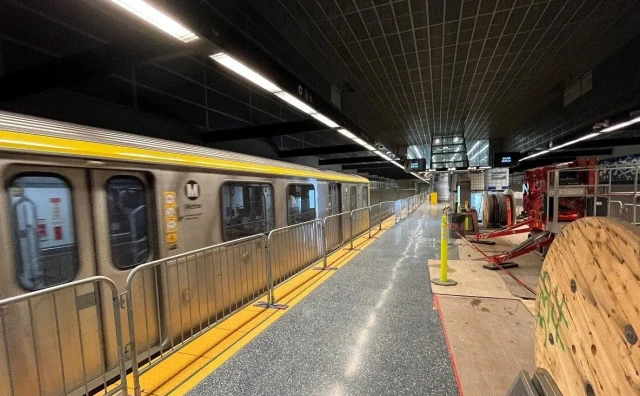With our free press under threat and federal funding for public media gone, your support matters more than ever. Help keep the LAist newsroom strong, become a monthly member or increase your support today during our fall member drive.
Spacecraft Model Points the Way to the Moon
DEBBIE ELLIOTT, Host:
NPR's Nell Boyce recently got a tour.
NELL BOYCE: Johnson Space Center in Houston is a sprawling place. It's so big that each building gets a number. Building 9 is like an aircraft hangar. Inside are full-scale exact replicas of NASA spacecraft.
SKIP HATFIELD: This is our mockup of training facility. The astronauts are trained out here for station and shuttle missions.
BOYCE: Skip Hatfield takes me past huge gleaming models of the shuttle and the space station. We're headed to a model of the ship his office is working on, Orion. It's a bell-shaped capsule that NASA wants to send to the moon by 2020.
HATFIELD: Right now, we're standing in front of a mockup that we used for developing the interior of the capsule. And it's primarily to physically lay out how the vehicle's going to look.
BOYCE: Astronaut Scott Altman has been helping to design Orion. He says this model reminds him of the old days when he was a kid reading comic books.
SCOTT ALTMAN: And you could order a submarine or something on the back page of the comic book for your own house. It would come made out of cardboard and you could build it in your living room and it'd be pretty close to what we have right here.
BOYCE: Still, Altman says a model like this one can sometimes can be more useful than fancy computer simulations or other high tech design tools. To see what he means, we climb in through the hatch.
ALTMAN: So my first question is, where do you want to sit?
BOYCE: Alright, well, I want to be the pilot.
ALTMAN: Okay. You can go over to seat number five.
BOYCE: We're on our backs with our legs sticking in the air.
ALTMAN: You can see we have displays in front of us.
BOYCE: The boxy display panel is Velcro-ed to the ceiling, but it's kind of falling down. Altman props it up. Two plastic sheets mimic computer screens. They show photos of a potential landing site in Australia.
ALTMAN: Well, one of the things we did is we looked at display sizing. So if I'm sitting in a seat like this, clearly I can see this display pretty well and that one, but looking over there is a little bit harder. And it's hard to get that feel in just a virtual world, so we come over here and evaluate that.
BOYCE: Behind us are two windows. There's no glass, just foam board frames. Each has a different shape.
ALTMAN: We're evaluating different window concepts, what's big enough.
BOYCE: So which one do you like better?
ALTMAN: Well, bigger windows are always better. That's kind of what I know so far.
BOYCE: NASA wants Orion to carry four to six astronauts. But this capsule feels cramped and we're not even wearing bulky space suits. Altman says they've had drills in here to see how hard it is move around.
ALTMAN: If there was an emergency, we have a requirement that says you can get out within two minutes. So we put on all our suits and strapped in like we were on the pad and then they hit the stop watch and we all started trying to get out.
BOYCE: On the metal staircase outside of the mockup, we run into Tim Reynolds, the guy who's in charge of building these models.
TIM REYNOLDS: Yeah, it's very exciting stuff. And it keeps us busy because they want to change it every month.
BOYCE: Nell Boyce, NPR News. Transcript provided by NPR, Copyright NPR.
At LAist, we believe in journalism without censorship and the right of a free press to speak truth to those in power. Our hard-hitting watchdog reporting on local government, climate, and the ongoing housing and homelessness crisis is trustworthy, independent and freely accessible to everyone thanks to the support of readers like you.
But the game has changed: Congress voted to eliminate funding for public media across the country. Here at LAist that means a loss of $1.7 million in our budget every year. We want to assure you that despite growing threats to free press and free speech, LAist will remain a voice you know and trust. Speaking frankly, the amount of reader support we receive will help determine how strong of a newsroom we are going forward to cover the important news in our community.
We’re asking you to stand up for independent reporting that will not be silenced. With more individuals like you supporting this public service, we can continue to provide essential coverage for Southern Californians that you can’t find anywhere else. Become a monthly member today to help sustain this mission.
Thank you for your generous support and belief in the value of independent news.

-
Restaurants share resources in the food hall in West Adams as Los Angeles reckons with increasing restaurant closures.
-
It will be the second national day of protest against President Donald Trump.
-
The university says the compact, as the Trump administration called it, could undermine free inquiry and academic excellence.
-
This is the one time you can do this legally!
-
Metro officials said it will be able to announce an opening date “soon.”
-
While working for the county, the DA’s office alleges that 13 employees fraudulently filed for unemployment, claiming to earn less than $600 a week.







